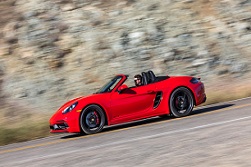American exceptionalism is a hotly debated subject, but Porsche has revealed an area of red, white, and blue leadership that sports car lovers can all rally behind: The U.S. market buys the highest percentage of new Porsches equipped with traditional H-pattern manual transmissions. U-S-A! U-S-A!

They still only account for a little more than a quarter of the brand’s cars on which throwback DIY gearboxes are available, according to Porsche spokesman Luke Vanderzande, but that is enough to help ensure the continued production of our preferred transmission type.
Which is good, because the six-speed manual transmission available on the $91,000 2018 718 Boxster GTS is more engaging and fun than an automatically shifted seven-speed PDK dual clutch cog-swapper. But the PDK is indisputably faster.
2018 Porsche 718 Boxster GTS first drive 2018 Porsche 718 Boxster GTS first drive 2018 Porsche 718 Boxster GTS first drive
But we don’t usually buy drop-top sports cars like the Boxster for quantifiably rational reasons, or we’d likely choose its marginally more sensible hardtop fraternal twin, the Cayman.
One reason to do that used to be the fact that the closed-roof version of the car was significantly more rigid than the open-top one, which let the suspension and steering do their jobs as designed without the interference of an undamped spring in the form of the twisting, bending chassis.
The 718-generation of the cars brought a substantial increase in structural rigidity, a factor that is particularly relevant to the stiffer-sprung GTS versions, according to 718 chassis project manager Joachim Meyer.
In the original iteration, the base variety of the Boxster was better-handling than the Boxster S on anything other than smooth pavement because the S' stiffer suspension simply twisted that car’s limp chassis over bumps. "The current 718 has very high rigidity,” Meyer explained.
We don’t usually buy drop-top sports cars like the Boxster for quantifiably rational reasons.
That admirably rigid unibody benefits handsomely from the GTS suspension, which is lowered by 0.39 inches (10mm) in standard form and by 0.78 inches (20mm) when equipped with the sport chassis option. The PASM active shocks are programmed to be stiffer, the GTS rolls on 20-inch base wheels, and the hollow anti-roll bars are both larger in diameter and have thicker-wall tubing. The standard 10-spoke Carrera S4 wheel looks the best to my eye, but there are three other optional 20-inchers for variety.
All this hardware combines to produce a car that stays remarkably flat when slicing up the curves of California’s Napa Valley during Porsche’s press introduction of the car. Porsche Torque Vectoring selectively applies the inside brake while turning to help induce even sharper cornering response in the twisties.
Which is good, because the six-speed manual transmission available on the $91,000 2018 718 Boxster GTS is more engaging and fun than an automatically shifted seven-speed PDK dual clutch cog-swapper. But the PDK is indisputably faster.
2018 Porsche 718 Boxster GTS first drive 2018 Porsche 718 Boxster GTS first drive 2018 Porsche 718 Boxster GTS first drive
But we don’t usually buy drop-top sports cars like the Boxster for quantifiably rational reasons, or we’d likely choose its marginally more sensible hardtop fraternal twin, the Cayman.
One reason to do that used to be the fact that the closed-roof version of the car was significantly more rigid than the open-top one, which let the suspension and steering do their jobs as designed without the interference of an undamped spring in the form of the twisting, bending chassis.
The 718-generation of the cars brought a substantial increase in structural rigidity, a factor that is particularly relevant to the stiffer-sprung GTS versions, according to 718 chassis project manager Joachim Meyer.
In the original iteration, the base variety of the Boxster was better-handling than the Boxster S on anything other than smooth pavement because the S' stiffer suspension simply twisted that car’s limp chassis over bumps. "The current 718 has very high rigidity,” Meyer explained.
We don’t usually buy drop-top sports cars like the Boxster for quantifiably rational reasons.
That admirably rigid unibody benefits handsomely from the GTS suspension, which is lowered by 0.39 inches (10mm) in standard form and by 0.78 inches (20mm) when equipped with the sport chassis option. The PASM active shocks are programmed to be stiffer, the GTS rolls on 20-inch base wheels, and the hollow anti-roll bars are both larger in diameter and have thicker-wall tubing. The standard 10-spoke Carrera S4 wheel looks the best to my eye, but there are three other optional 20-inchers for variety.
All this hardware combines to produce a car that stays remarkably flat when slicing up the curves of California’s Napa Valley during Porsche’s press introduction of the car. Porsche Torque Vectoring selectively applies the inside brake while turning to help induce even sharper cornering response in the twisties.
PTV also has a locking differential at its disposal, which it can apply when needed to assist the driver. These functions are utterly transparent, so there is no ability to discern PTV at work, other than to appreciate how nimble the Boxster is ripping through continuous switchbacks.
motor1.com
By:
Dan Carney, Contributing Writer
motor1.com
Latest News


